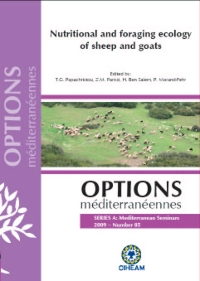| Article précédent | p. 267-272 | Article suivant |
Efficacy of eucalyptus oil on in vitro ruminal fermentation and methane production
The in vitro semi automated gas production (GP) technique has been used to evaluate the potential of different levels of eucalyptus (eucalyptus citriodora) oil (EuO, 25, 50, 100 and 150 µl) on total gas and methane production, as well as on rumen fermentation parameters. A total mixed ration (50% roughage:50% concentrate) was incubated with buffered rumen fluid. The EuO decreased GP by 5.3, 24.2, 44.6 and 56.7% with increasing level of oil. Also, the EuO at 25, 50, 100 and 150 µl linearly decreased CH4 production by 26.0, 46.8, 77.3 and 85.3%, respectively. There were no significant differences among investigated levels of EuO on the dry and organic matter degradation. The efficiency of microbial protein production was estimated by the partitioning factor (PF, estimated as the ratio of truly organic matter degradation and the gas volume produced at 24 h of incubation), expressed as mg/ml. The PF values were 3.79, 3.66, 3.58, 4.97 and 6.92 for control, 25, 50, 100 and 150 µl of eucalyptus oil, respectively. The ammonia-N concentration linearly decreased (P < 0.05) when the EuO was included. At 24 h of incubation, protozoa counts were reduced by 29.0, 38.7, 62.9 and 64.5%, respectively by adding 25, 50, 100 and 150 µl of EuO compared to the control. It is suggested that EuO could modify the rumen fermentation and has a potential in methane mitigation, which may be beneficial (at low level) for improving nutrient utilization and animal growth.
La production de gaz (PG) in vitro a été étudiée en utilisant la technique semi-automatique afin d'évaluer le potentiel de différents niveaux d'huile d'eucalyptus (Eucalyptus globulus) (HEu, 25, 50, 100 et 150 µl) sur la production de gaz total et de méthane, ainsi que d'autres paramètres de fermentation ruminale. Une ration complète (50% de fourrage:50% de concentré) a été incubée en présence du liquide de rumen tamponné. Les résultats ont montré que l'augmentation du niveau de HEu se traduit par une diminution de la PG de 5,3, 24,2, 44,6 et 56,7%. D'autre part, l'HEu aux niveaux 25, 50, 100 et 150 µl a linéairement diminué la production de méthane (26,0, 46,8, 77,3 et 85,3%, respectivement). L'administration d'HEu n'a pas affecté la dégradation de la matière sèche et de la matière organique. L'efficacité de la production de protéines microbiennes a été estimée par le facteur de division (FD, rapport entre la dégradation réelle de la matière organique et le volume de gaz produit après 24 h d'incubation), exprimé en mg/ml. Les valeurs de FD étaient de 3,79, 3,66, 3,58, 4,97 et 6,92 pour le témoin, 25, 50, 100 et 150 µl de l'HEu, respectivement. La quantité de l'HEu ajoutée était inversement proportionnelle aux concentrations d'azote ammoniacal (P < 0,05). Par comparaison au témoin (sans HEu), le nombre de protozoaires après 24 h d'incubation a chuté de 29,0, 38,7, 62,9 et 64,5%, respectivement avec les niveaux 25, 50, 100 et 150 µl de l'HEu. Il ressort que l'HEu pourrait modifier la fermentation ruminale et avoir un potentiel pour la réduction du méthane, ce qui encourage à l'utiliser à faible dose pour améliorer l'utilisation des nutriments et la croissance de l'animal.
- [ Afficher ]
- [ Télécharger ]
- [ Exporter la citation ]
Vous pouvez télécharger la citation au format :
- [ Imprimer ]
-
Mots-clés
DIGESTION DU RUMEN, EUCALYPTUS, EXPERIMENTATION IN VITRO, FERMENTATION, HUILE VEGETALE, MESURE, METHANECiter cet article
Sallam S.M.A., Bueno I.C.S., Brigide P., Godoy P.B., Vitti D.M.S.S., Abdalla A.L. Efficacy of eucalyptus oil on in vitro ruminal fermentation and methane production. In : Papachristou T.G. (ed.), Parissi Z.M. (ed.), Ben Salem H. (ed.), Morand-Fehr P. (ed.). Nutritional and foraging ecology of sheep and goats. Zaragoza : CIHEAM / FAO / NAGREF, 2009. p. 267-272. (Options Méditerranéennes : Série A. Séminaires Méditerranéens; n. 85). 12. Seminar on: Nutritional and Foraging Ecology of Sheep and Goats, 2007/10/11-13, Thessaloniki (Greece). http://om.ciheam.org/om/pdf/a85/00801016.pdf



